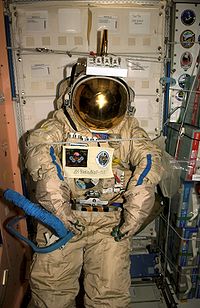DiFMDA
DiFMDA | |
| 임상자료 | |
|---|---|
| ATC 코드 |
|
| 법적현황 | |
| 법적현황 | |
| 식별자 | |
| |
| CAS 번호 | |
| 펍켐 CID | |
| 켐스파이더 | |
| 유니 | |
| CompTox 대시보드 (EPA) | |
| 화학 및 물리적 데이터 | |
| 공식 | C10H11F2NO2 |
| 어금질량 | 215.200 g·2010−1 |
| 3D 모델(JSmol) | |
| |
| |
| | |
Difluoromethylenedioxyamphetamine (DiFMDA) is a substituted derivative of 3,4-methylenedioxyamphetamine (MDA), which was developed by Daniel Trachsel and coworkers, along with the corresponding fluorinated derivatives of MDMA, MDEA, BDB and MBDB, with the aim of finding a non-neurotoxic drug able to be used as a less harmful substitute for entactogMDMA와 같은 에닉 약물. 이들 화합물의 정상적인 신진대사의 주요 경로는 알파 메틸도파민 같은 신경독성 대사물을 생성하는 메틸렌디옥시 링의 파편이므로, 디플루오메틸렌디옥시 바이오이소스테레(difluoromethylenedioxy bioisostére)[1][2]가 대사 안정성이 높아지고 독성이 감소하는 것을 보여주기를 기대했다.
비록 체외 바인딩 연구 DFMDA 그 MDA과 MDMA.[3]의 대량 관용의 분자, 쉐의 이 위치에서 부족한 알려진 하지만, 있습니다 사이에는 SERT 호감을 보일 프로그램을 이 화합물 아직 동물들에서 그들은non-fluorinated 부모 합성 물질을 비슷한 약리학적 활동을 보여 주는지 확인하기 위해 시험을 받지 않았던.자신의 에틸리덴디옥시 및 이소프로필렌디옥시 아날로그의 일반적으로 감소된 활성도에 의해.[4][5] MDMA 신경독성은 다양한 원인에 의해 발생하며 알파메틸도파민의 축적 때문만은 아니라는 점도 현재 일반적으로 받아들여지고 있어 신경독성 DFMDA와 관련 약물이 얼마나 적게 실전에 있을지는 불분명하다.[6][7][8]
참조
- ^ Trachsel D, Hadorn M, Baumberger F (March 2006). "Synthesis of fluoro analogues of 3,4-(methylenedioxy)amphetamine (MDA) and its derivatives". Chemistry & Biodiversity. 3 (3): 326–36. CiteSeerX 10.1.1.688.5803. doi:10.1002/cbdv.200690035. PMID 17193269. S2CID 23036634.
- ^ Meanwell NA (March 2011). "Synopsis of Some Recent Tactical Application of Bioisosteres in Drug Design". Journal of Medicinal Chemistry. 54 (8): 2529–91. doi:10.1021/jm1013693. PMID 21413808.
- ^ Walline CC, Nichols DE, Carroll FI, Barker EL (June 2008). "Comparative molecular field analysis using selectivity fields reveals residues in the third transmembrane helix of the serotonin transporter associated with substrate and antagonist recognition". The Journal of Pharmacology and Experimental Therapeutics. 325 (3): 791–800. doi:10.1124/jpet.108.136200. PMC 2637348. PMID 18354055.
- ^ Nichols DE, Kostuba LJ (October 1979). "Steric effects of substituents on phenethylamine hallucinogens. 3,4-(Methylenedioxy)amphetamine analogues alkylated on the dioxole ring". Journal of Medicinal Chemistry. 22 (10): 1264–7. doi:10.1021/jm00196a022. PMID 513074.
- ^ Nichols DE, Oberlender R, Burris K, Hoffman AJ, Johnson MP (November 1989). "Studies of dioxole ring substituted 3,4-methylenedioxyamphetamine (MDA) analogues". Pharmacology Biochemistry and Behavior. 34 (3): 571–6. doi:10.1016/0091-3057(89)90560-1. PMID 2623014. S2CID 7560526.
- ^ Capela JP, Carmo H, Remião F, Bastos ML, Meisel A, Carvalho F (June 2009). "Molecular and cellular mechanisms of ecstasy-induced neurotoxicity: an overview". Molecular Neurobiology. 39 (3): 210–71. CiteSeerX 10.1.1.670.6897. doi:10.1007/s12035-009-8064-1. PMID 19373443. S2CID 21190104.
- ^ Sarkar S, Schmued L (August 2010). "Neurotoxicity of ecstasy (MDMA): an overview". Current Pharmaceutical Biotechnology. 11 (5): 460–9. doi:10.2174/138920110791591490. PMID 20420572.
- ^ Escubedo E, Abad S, Torres I, Camarasa J, Pubill D (January 2011). "Comparative neurochemical profile of 3,4-methylenedioxymethamphetamine and its metabolite alpha-methyldopamine on key targets of MDMA neurotoxicity". Neurochemistry International. 58 (1): 92–101. doi:10.1016/j.neuint.2010.11.001. PMID 21074589. S2CID 2853533.


